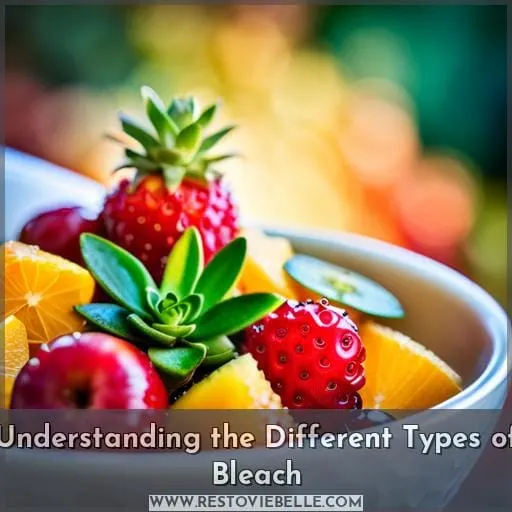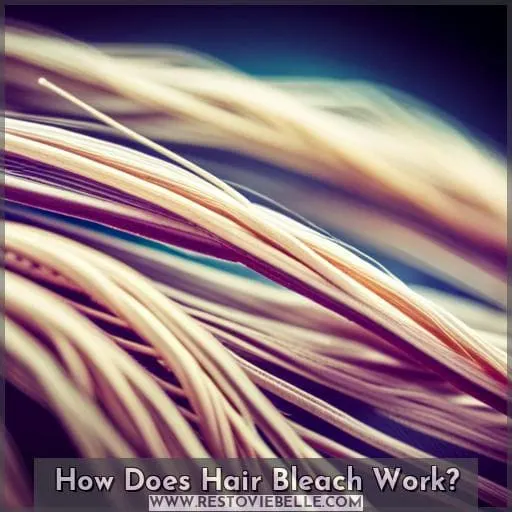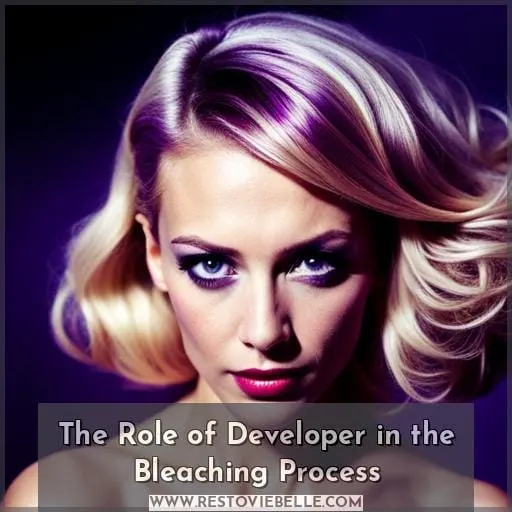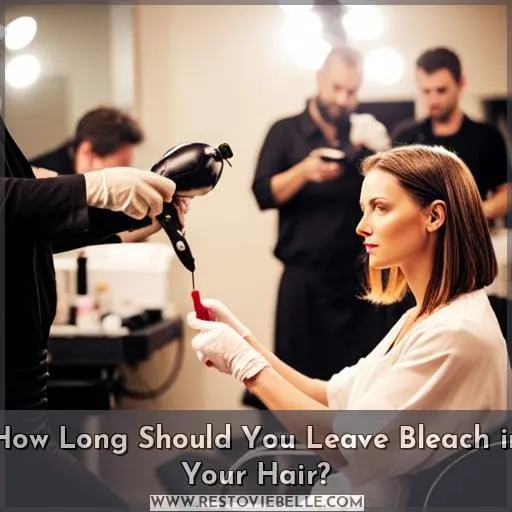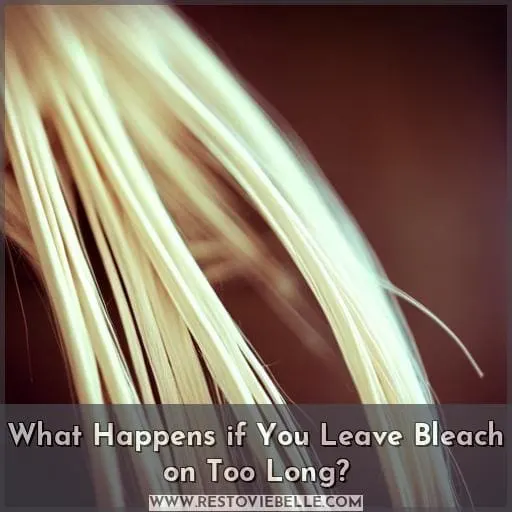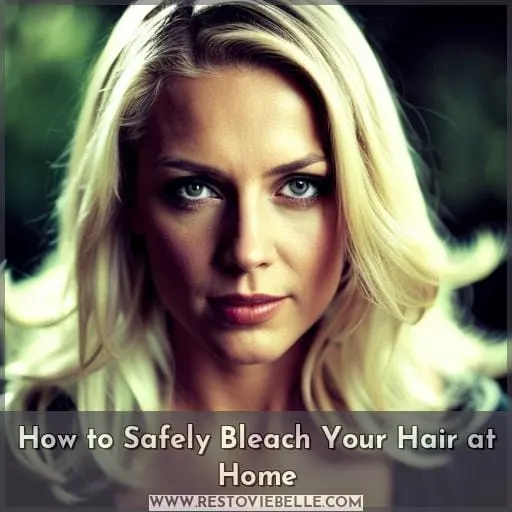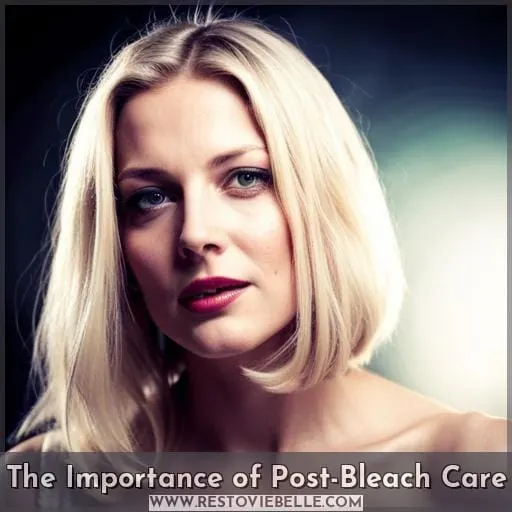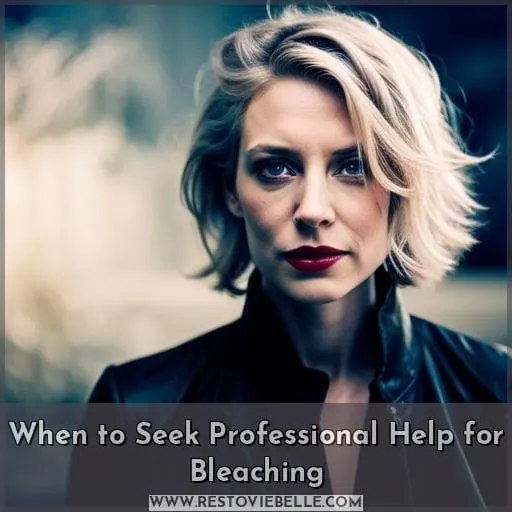This site is supported by our readers. We may earn a commission, at no cost to you, if you purchase through links.
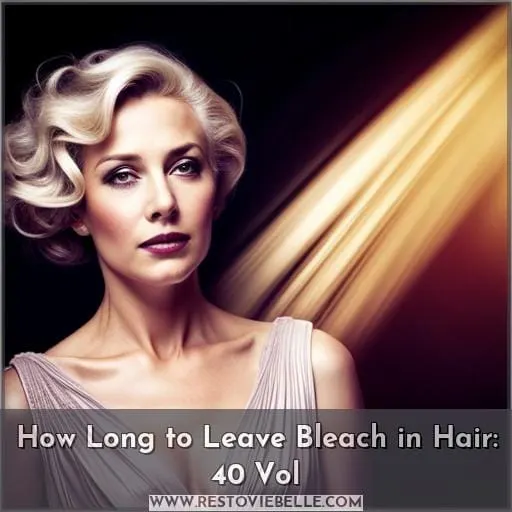 Driving the desire for a brighter, lighter hair color can be hard to resist. But if you’re using bleach in your hair, understanding how long to leave it on is key – especially when working with 40 vol developer.
Driving the desire for a brighter, lighter hair color can be hard to resist. But if you’re using bleach in your hair, understanding how long to leave it on is key – especially when working with 40 vol developer.
We’ll cover what exactly bleaching entails and why developer plays an important role before diving into advice about safely leaving bleach in at home and post-bleach care tips too.
Table Of Contents
- Key Takeaways
- What is Hair Bleach?
- Understanding the Different Types of Bleach
- How Does Hair Bleach Work?
- The Role of Developer in the Bleaching Process
- How Long Should You Leave Bleach in Your Hair?
- What Happens if You Leave Bleach on Too Long?
- How to Safely Bleach Your Hair at Home
- The Importance of Post-Bleach Care
- How Soon Can You Re-Bleach Your Hair?
- When to Seek Professional Help for Bleaching
- Conclusion
Key Takeaways
- Timing guidelines for 40 vol bleach: a maximum of 30 minutes, but shorter times are recommended for safety.
- Strand testing is crucial before applying 40 vol bleach to the entire head.
- Overexposure to 40 vol bleach can lead to severe hair damage.
- Prepping and caring for hair before and after bleaching is essential for desired results.
What is Hair Bleach?
You know what it takes to make your hair lighter and brighter – bleach! It contains hydrogen peroxide, lightens up the locks, and comes in different concentrations so you can get just the right amount of lift.
Hair bleaching is a three-step process. First, you mix a bleach mixture with developer (usually 20 vol). Then, you apply it to dry hair using an applicator bottle or brush. Finally, you allow it to sit for no more than 30 minutes before rinsing out.
Different types of bleaches have varying effects on the cortex of the hair. For example, 40 vol will give 4-5 levels of lift while 10 vol lifts 1-2 levels. However, the latter requires extra care during application to avoid overprocessing.
For maximum safety when working with high volumes such as 40 volume developer, be sure not to leave your bleach mixture in longer than 20 minutes. Any additional time could cause severe damage due to excess exposure from hydrogen peroxide in this strength level.
This could lead to permanent breakage and color loss if left on strands for too long.
The most important aspect when working with at-home bleaching kits is precision. Always measure out equal parts correctly for the best results and follow all instructions closely!
Understanding the Different Types of Bleach
It’s important to understand the varying strengths of bleach, as each type can have a different effect on hair. Different bleaching techniques use different concentrations and volumes of hydrogen peroxide that correspond with various levels of lift and color variation.
40 vol (or 12 percent) strength is suitable for lifting up to four or five shades at once, making it ideal for open-air processing but not recommended when using regular bleach. Root timing also depends on the hair’s natural color and any previous dyeing history; dark hues may need multiple treatments over time to achieve desired results.
When using 40 vol strength, maximum exposure time should be limited to no more than 30 minutes due to its higher concentration in order to avoid extensive damage from overexposing your strands. It’s also essential not to forget post-bleach care such as conditioning masks or thermal protection sprays, which help keep locks healthy after lightening them significantly.
How Does Hair Bleach Work?
When it comes to bleaching your hair, the concentration of hydrogen peroxide in the bleach will determine how quickly you should be done. With 40 vol developer, the maximum time for bleaching is 30 minutes as it can cause serious damage if left on too long.
The process begins with opening up the cuticles and dissolving melanin, which results in pigment breakdown and a lightening effect. It’s important to remember that timing varies depending on the type of bleach you use.
For 40 vol, the recommended time is 10-20 minutes, for 30 vol it’s a maximum of 20 minutes, and for 10 vol it’s up to 30 minutes.
Darker hair might need multiple treatments or a longer time when using higher volumes like 40 vol because more pigments need to be broken down. To avoid any sort of damage from overbleaching, it’s important to check every ten minutes until the desired color has been reached.
Then, rinse off completely with cool water followed by shampooing and conditioning for the best result.
The Role of Developer in the Bleaching Process
You’ll need to pick the right developer when bleaching your hair to get the desired results. Developer strength affects how much cuticle opening and color penetration occurs, so precision measuring is key for best results.
For 40 vol bleach, you should only use a matching developer of at least 30 vol (or higher) in order to avoid damage from overexposure. The combination of bleach and developer will open up the cuticles on your hair strands, allowing the lightening agent to penetrate deeply into each strand before being rinsed away after processing time has elapsed.
It’s important that you follow all instructions carefully if using a home bleaching kit or going through with salon services – this way you can achieve optimal lift without compromising on quality or safety! Knowing how exactly developers work alongside bleach will help ensure successful outcomes every time you choose to lighten up your locks!
How Long Should You Leave Bleach in Your Hair?
Are you considering bleaching your hair? If so, one of the most important decisions to make is how long to leave bleach in. Depending on the type and strength of the developer used, it can range from 10 minutes for a 30 volume up to 30 minutes when using 40 volume peroxide.
Timing Guidelines for 40 Volume Bleach
For optimal results, timing is critical when applying 40 volume bleach to your hair. To avoid damage, the maximum exposure time should not exceed 30 minutes; shorter times are recommended for best safety.
For full-head blonde looks with dark hair, multiple treatments may be necessary to achieve a desired color.
Hair protection tips include using an oil or conditioner before bleaching and applying a post-bleach shampoo afterwards.
Following these guidelines can help you get the look you’re after without risking excessive damage from overexposure!
- Maximum exposure time for 40 vol bleach should not exceed 30 minutes
- Multiple treatments may be needed for darker hair colors
- Use protective pre/post treatment (conditioner/oil & shampoo)
Factors to Consider for Individual Hair Types
Considering your individual hair type is essential when determining how much time to leave 40 volume bleach in your hair. Texture, color assessment, and patch testing are all important considerations before using a developer strength of 40 vol.
For coarse or dark-colored hair, the risk of damage is higher, and more caution needs to be taken with timing. Aftercare routine, such as weekly treatments and deep conditioning, will help minimize any potential damage from bleaching.
Regular trims can also reduce the possibility of split ends forming over time due to chemical processing.
Taking into account these factors prior to bleaching will ensure that you get beautiful results without causing any unnecessary damage!
What Happens if You Leave Bleach on Too Long?
If you’re not mindful of the timeframe, you may find yourself with a scalp that’s screaming for mercy! 40 vol bleach is incredibly powerful and should never be left in your hair for longer than 20 minutes.
Overexposure can cause severe damage to your hair strands, leaving them dry and brittle.
Your color lines will suffer too as this oxidizing agent breaks down melanin quickly without proper timing. Using generic developer or higher concentrations than what are recommended can also lead to irreversible consequences such as keratin loss or patchy results when bleaching at home or during an appointment at the salon.
The best way to avoid these issues is by doing a strand test prior so you know exactly how long it takes based on your specific needs before jumping into a full-head application of bleach products.
A bleach bath might be gentler but still requires precise timing otherwise its effects will become more damaging rather than beneficial toward achieving desired results – especially if done frequently over time!
When caring for bleached hair, it’s important to use conditioners and masks regularly while avoiding any further chemical treatments until 6-8 weeks later post-bleach session have passed by safely.
How to Safely Bleach Your Hair at Home
Bleaching your hair at home can be a daunting task, but with the right preparation and attention to detail, it can become a simple process. Knowing how long to leave bleach in your hair is especially important when using a 40 vol developer.
Preparing Your Hair for Bleaching
Before bleaching, assess your hair’s condition and do a patch test to ensure safety. Check porosity and scalp sensitivity as they can affect how the bleach will interact with your strands.
Do a strand test for color accuracy and timing too – it should take 15-30 minutes before you see results that correspond to the developer volume used.
Pre-shampoo conditioning is essential for cuticle protection, so use a protective spray beforehand as well!
After washing, apply moisture-retaining conditioners. Leave them in for 5 minutes, then rinse with cold water or use the cool down setting on your hairdryer.
Finally, make sure all products are compatible by testing them together prior to application. This helps achieve desired results while minimizing damage from prolonged exposure or overlapping ingredients.
Step-by-Step Instructions for Applying Bleach
Now it’s time to apply the bleach! Remember that when using 40 vol developer, extra care is needed as this concentration can lift up to five levels of color in just 10 minutes.
To ensure a safe and successful lightening process, start at the back of your head. Work in small sections and pay attention to timing. Apply the mixture evenly throughout each section and keep track with a timer or watch for consistent results.
Finish by following post-bleach instructions such as deep conditioning, toning, shampooing, etc.
The Importance of Post-Bleach Care
It is essential to take good care of your hair after bleaching it. Shampooing and conditioning regularly, using deep conditioning masks and treatments, as well as protecting your hair from damage, are all important steps in maintaining healthy locks.
Knowing how long to leave bleach in your hair with 40 vol developer for optimal results will help you achieve the desired look without risking any damage.
Shampooing and Conditioning After Bleaching
After bleaching, it’s essential to shampoo and condition your locks for optimal health. Use a sulfate-free shampoo and conditioner specifically designed for color-treated hair. Be careful not to strip away too much moisture from the strands as this can cause breakage.
If you’ve used a bleach bath, use lukewarm water and rinse until all residue is gone before applying the conditioning treatments.
Finally, remember that re-bleaching should always be done at least six weeks later in order to avoid any additional harm caused by doing so too soon after the initial bleaching session.
Using Hair Masks and Treatments
To help maintain your hair’s health after bleaching, consider incorporating masks and treatments into your routine. In fact, 80% of hairstylists recommend using a weekly mask. Hair repair treatments can restore moisture and alleviate possible damage from the bleach.
Deep conditioning is also beneficial as it helps to replenish nutrients lost during the bleaching process. Masks with natural ingredients are best for restoring texture while protecting against pigment loss due to sun exposure or chemical processes like dyeing and straightening.
A thermal protector spray should also be used prior to heat styling for added protection against breakage caused by blow-drying or curling irons.
Protecting Your Hair From Damage
You’d really want to keep your hair protected after using such a high volume developer. A bleach bath is an effective way of lightening without the intensity of 40 vol but still reaching desired results.
For protein protection, use deep conditioners or masks specifically formulated for bleached hair to replenish lost keratin.
Cuticle care should be taken seriously. Use post-bleach treatments like moisturizing creams or serums to reduce dryness and breakage caused by chemical damage.
Safe timing is also essential. Avoid leaving bleach in for more than 30 minutes as it can lead to irreversible damage from overprocessing.
An intensive after-color treatment will help protect your hair from further harm while restoring its health and shine!
How Soon Can You Re-Bleach Your Hair?
Once you’ve bleached your hair, it’s important to wait at least 6-8 weeks before re-bleaching in order to avoid irreversible damage.
- Hair health: If the hair is weak or dry due to previous treatments, a longer waiting period should be observed.
- Bleaching precautions: Always follow instructions and use protective products for best results.
- Color correction: Relying solely on bleach can lead to uneven color tones; toning may be necessary for desired results.
- Safe intervals: Wait until there are visible signs of natural regrowth before attempting another treatment with 40 vol bleach developer once again.
When considering how soon one can safely re-bleach their hair, it’s essential that all safety guidelines are followed closely in order to maintain healthy tresses and achieve optimal outcomes from each session without putting any strain on the scalp or strands themselves.
Furthermore, scheduling regular trims every six weeks will help prevent split ends caused by chemical treatments while also allowing time for proper rest between sessions.
When to Seek Professional Help for Bleaching
If bleaching your hair is proving too challenging, it’s best to seek professional help. Using a 40 vol developer carries a high risk of overexposure and damage. An experienced stylist can assess your hair’s health and provide expert advice on safe practices, such as timing and product use.
Professional consultation ensures that you achieve the desired results with a lower chance of adverse consequences like breakage or discoloration.
Additionally, a professional hairdresser can accurately measure out products, eliminating any room for error when mixing bleach or colorant solutions. This is especially important when getting your hair done in a salon rather than at home.
By seeking out an experienced hairdresser, you can guarantee optimal outcomes while protecting your locks from further harm due to overbleaching. This way, you can look fabulous without compromising the long-term health of your hair.
Conclusion
In a nutshell, bleaching your hair at home can be an effective way to achieve lighter locks, but it’s important to understand the process and the risks involved. The type of bleach and the strength of the developer can make a huge difference in how long to leave bleach in your hair and the outcome of the color.
When using 40 vol developer, the maximum bleach time is 20 minutes. Any longer, and you risk serious damage. Taking the time to prep and care for your hair before, during, and after bleaching is essential for achieving the desired results while avoiding permanent damage.
With the right precautions, you can achieve beautiful bleached hair.

